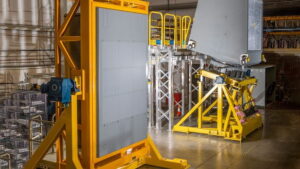Raytheon Technologies [RTX] delivered the first of three SPY-6 Enterprise Air Surveillance Radar (EASR) faces to the future USS John F. Kennedy
(CVN-79) aircraft carrier, the company said on Monday.
CVN-79 will be the first carrier to receive this radar, specifically in the SPY-6(V)3 format. The company said this variant has three fixed-face array faces, each with nine Radar Modular Assemblies (RMAs). Each RMA is a two foot by two foot by two foot radar box that stacks together to make an array face, which the company underscored makes it scalable.
The company said this SPY-6 radar provides 360-degree coverage for the ship and this SPY-6(V)3 variant has particular features for the aircraft carrier like weather mapping and air traffic control functionality.
“This is the first aircraft carrier that will be equipped with SPY-6 radars, the leading naval radar system in the world,” said Kim Ernzen, president of naval power at Raytheon’s Missiles & Defense business unit.

This comes after the Navy awarded Raytheon a $651 million contract on March 31 for hardware production of the AN/SPY-6(V) family of radars. That contract includes options that, if awarded, could raise the total value up to $3.16 billion. The work is expected to finish by November 2025 or June 2028 if the options are awarded.
The March contract aims to help equip up to 31 Navy ships with SPY-6 radars. Ernzen said that the recent award will make the SPY-6 radar important in the near future.
“With the recent contract, SPY-6 will provide premier detection and coverage for more than 40 ships in the U.S. Navy throughout the next decade,” Ernzen added.
In addition to the Ford-class carriers, the March contract covers producing radars for Arleigh Burke-class (DDG-51) Flight III destroyers, amphibious ships, and backfitting to upgrade DDG-51 Flight II destroyers.
Raytheon has already installed the SPY-6 on the first DDG-51 Flight III, the future USS Jack H. Lucas (DDG-125), and delivered radar arrays for the next Flight III vessel, the future USS Ted Stevens (DDG-128).
The SPY-6 EASR was originally meant to enter the fleet with the future USS Enterprise (CVN-80) and the USS Bougainville (LHA-8) America-class amphibious assault ship. In contrast, the first new carrier of the class, the USS Gerald R. Ford (CVN-78), uses a Dual Band Radar (DBR) originally designed and built for the Zumwalt-class destroyers.
The Navy originally planned to buy up to 27 Zumwalt-class destroyers and the DBR would work for the carriers also at that scale. However, when the Navy cut the DDG-1000s to three destroyers due to cost issues, the cost of using DBR on the carriers became too high, so the Navy sought a different radar, the SPY-6 EASR.
The AN/SPY-6(V)1 is designed to be used on Flight III DDG-51 destroyers; the (V)2 EASR is for Flight II San Antonio-class amphibious transport dock ships, America-class amphibious assault ships, and retrofitting Nimitz-class carriers; (V)3 on Ford-class radars and Constellation-class frigates; and (V)4 will be retrofitted to DDG-51 Flight IIA destroyers.